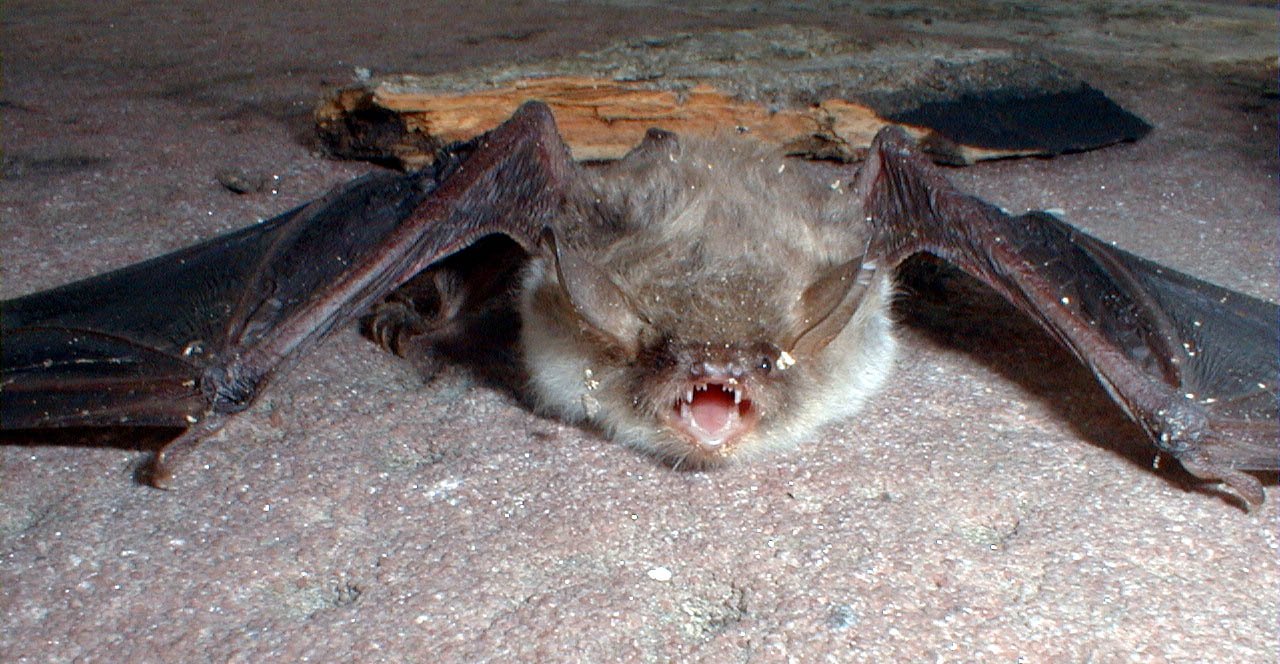Long-Eared Myotis: Myotis Evotis

Physical Characteristics Of The Long-Eared Myotis
Myotis evotis are equipped with black ears and a pale-brown/straw-colored coat. The average size of a long-eared myotis bat includes:
- Total Length: 87-100mm
- Ear Length: 19-22mm
- Tragus (inner ear): Long & Slender
Myotis evotis shows minimal sexual dimorphism, with females being slightly larger than males, although only slight ear and fifth metatarsal length differences are shown.
Evidence of geographical variation in size is available. There are larger skulls of evotis from British Columbia than those from Washington; Washington bats are more similar to those found further inland. 1Go To Source animaldiversity.org -“Myotis evotis western long-eared myotis”
Learn More: Types Of Bat In The United States
Long-Eared Myotis Behavior
At pre-dawn and dusk, northern long-eared myotis are nocturnal with periods of increased activity. To satisfy their daily energy and resting needs, they maintain large home ranges. In small colonies, they frequently relocate roosts.
Myotis in the North are short-distance migrants. They have been documented from hibernacula to summer colonies, traveling up to 168 miles. They were also recorded during the winter to move between hibernacula.
The long-eared bat captures prey via aerial hawking and gleaning insects from vegetation. By passive detection and gleaning, the northern myotis can locate a broader range of insect prey than echolocating bats. 2Go To Source guides.nynhp.org -“Northern Long-eared Bat”
Reproduction Habits Of Long-Eared Myotis
Mating typically occurs in the fall. Young bats are born between May and July, with a peak in June. The average annual litter is 1 baby bat. The majority of young begin to fly in early August. The maximum recorded life expectancy is 22 years. 3Go To Source nrm.dfg.ca.gov -“LONG-EARED MYOTIS Myotis evotis”
Long-Eared Myotis Prefered Habitats
This bat species is strongly linked to wooded habitats with tendencies to forage along ridges and hillsides under the forest canopy. In winter, long-eared myotis hibernate in caves and abandoned mines, often with other species of bats.
Easily overlooked in caves, as in narrow crevices where they are not easily observed, this small bat will often roost. Females long-eared myotis bats form small maternity colonies in hollow trees, under exfoliating bark, or buildings during the summer months. Isolated males can be found year-round in caves. 4Go To Source outdooralabama.com -“Northern Long-eared Myotis”
Range Of The Long-Eared Myotis Species

The long-eared bat is widely distributed throughout much of Canada and the United States, but populations are patchy and rarely found in groups of more than 100 bats.
The species occurs in all the provinces of Canada, in the Yukon, most of the United States. Montana and Wyoming have also reported a small number of long-eared bat sightings. It is considered vulnerable or imperiled across much of its range, but the southern populations are much smaller than the northern populations. 5Go To Source biologicaldiversity.org -“NATURAL HISTORY NORTHERN LONG-EARED BAT”
Long-Eared Bat Diet
Long-eared myotis bats are known to eat moths, beetles, flies, lacewings, true bugs, and spiders. A stomach content analysis from 3 long-eared bats revealed the bats had eaten:
- Cicadellid (leafhopper)
- Chironmid (lake fly)
- Small Moth
- Scarab Beetle
- Dragon Fly
- Bristly Muscoid Fly 6Go To Source fieldguide.mt.gov -“Long-eared Myotis – Myotis evotis”
Conservation Of The Long-Eared Bat
The long-eared bat is a species that has been dramatically affected by the white-nose syndrome disease. The northern long-eared bat was listed on April 2, 2015, as threatened under the Endangered Species Act due to declines caused by white-nose syndrome and continued spread of the disease. 7Go To Source fws.gov -“Northern Long-Eared Bat (Myotis septentrionalis)”
Sources:
- Weber, C. 2004. “Myotis evotis” (On-line), Animal Diversity Web. Accessed January 04, 2021 at https://animaldiversity.org/accounts/Myotis_evotis/
- New York Natural Heritage Program. 2021. Online Conservation Guide for Myotis septentrionalis. Available from: https://guides.nynhp.org/northern-long-eared-bat/. Accessed January 4, 2021.
- Harris, J. “LONG-EARED MYOTIS Myotis Evotis.” California Department Of Fish And Wildlife, California Wildlife Habitat Relationships System, nrm.dfg.ca.gov/FileHandler.ashx?DocumentID=2323. Accessed 4 Jan. 2021.
- Henry, Travis. “Northern Long-Eared Myotis.” Outdoor Alabama, Alabama Department Of Conservation And Natural Resources, www.outdooralabama.com/bats/northern-long-eared-myotis. Accessed 4 Jan. 2021.
- “Natural History.” Center For Biological Diversity, www.biologicaldiversity.org/species/mammals/northern_long-eared_bat/natural_history.html. Accessed 4 Jan. 2021.
- Long-eared Myotis — Myotis evotis. Montana Field Guide. Montana Natural Heritage Program and Montana Fish, Wildlife and Parks. Retrieved on January 4, 2021, from http://FieldGuide.mt.gov/speciesDetail.aspx?elcode=amacc01070
- U.S. Fish and Wildlife Service. “Northern Long-Eared Bat (Myotis Septentrionalis).” U.S. Fish And Wildlife Service, 21 Mar. 2020, www.fws.gov/Midwest/Endangered/mammals/nleb/index.html.
